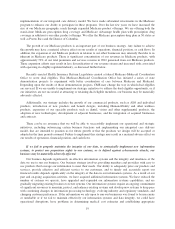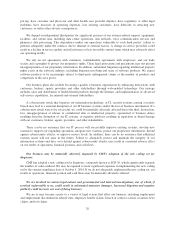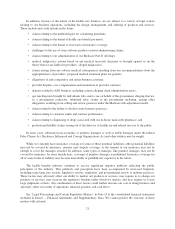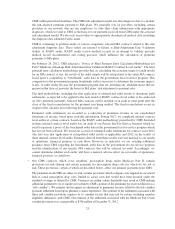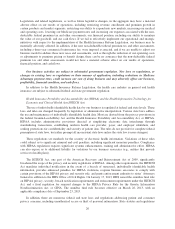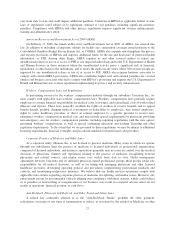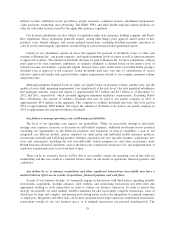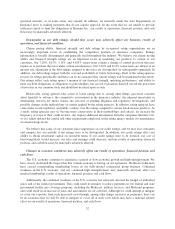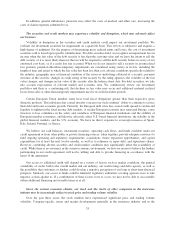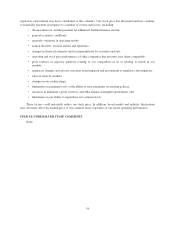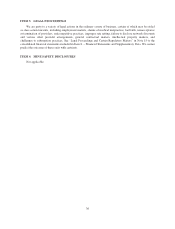Humana 2012 Annual Report Download - page 39
Download and view the complete annual report
Please find page 39 of the 2012 Humana annual report below. You can navigate through the pages in the report by either clicking on the pages listed below, or by using the keyword search tool below to find specific information within the annual report.delivery systems, utilization review procedures, quality assurance, complaint systems, enrollment requirements,
claim payments, marketing, and advertising. The HMO, PPO, and other health insurance-related products we
offer are sold under licenses issued by the applicable insurance regulators.
Our licensed subsidiaries are also subject to regulation under state insurance holding company and Puerto
Rico regulations. These regulations generally require, among other things, prior approval and/or notice of new
products, rates, benefit changes, and certain material transactions, including dividend payments, purchases or
sales of assets, intercompany agreements, and the filing of various financial and operational reports.
Certain of our subsidiaries operate in states that regulate the payment of dividends, loans, or other cash
transfers to Humana Inc., our parent company, and require minimum levels of equity as well as limit investments
to approved securities. The amount of dividends that may be paid to Humana Inc. by these subsidiaries, without
prior approval by state regulatory authorities, or ordinary dividends, is limited based on the entity’s level of
statutory income and statutory capital and surplus. In most states, prior notification is provided before paying a
dividend even if approval is not required. Actual dividends paid may vary due to consideration of excess
statutory capital and surplus and expected future surplus requirements related to, for example, premium volume
and product mix.
Although minimum required levels of equity are largely based on premium volume, product mix, and the
quality of assets held, minimum requirements vary significantly at the state level. Our state regulated subsidiaries
had aggregate statutory capital and surplus of approximately $5.1 billion and $4.7 billion as of December 31,
2012 and 2011, respectively, which exceeded aggregate minimum regulatory requirements. Excluding Puerto
Rico subsidiaries, the amount of ordinary dividends that may be paid to our parent company in 2013 is
approximately $911 million in the aggregate. This compares to ordinary dividends that were able to be paid in
2012 of approximately $860 million. We expect the amount of dividends to be paid to our parent company in
2013 to approximate the amount of ordinary dividends.
Any failure to manage operating costs could hamper profitability.
The level of our operating costs impacts our profitability. While we proactively attempt to effectively
manage such expenses, increases or decreases in staff-related expenses, additional investment in new products
(including our opportunities in the Medicare programs and expansion of clinical capabilities a part of our
integrated care delivery model), greater emphasis on small group and individual health insurance products,
investments in health and well-being product offerings, expansion into new specialty markets, acquisitions, new
taxes and assessments, including the new non-deductible federal premium tax and other assessments under
Health Insurance Reform Legislation, such as the three-year commercial reinsurance fee, and implementation of
regulatory requirements may occur from time to time.
There can be no assurance that we will be able to successfully contain our operating costs in line with our
membership and this may result in a material adverse effect on our results of operations, financial position, and
cash flows.
Any failure by us to manage acquisitions and other significant transactions successfully may have a
material adverse effect on our results of operations, financial position, and cash flows.
As part of our business strategy, we frequently engage in discussions with third parties regarding possible
investments, acquisitions, strategic alliances, joint ventures, and outsourcing transactions and often enter into
agreements relating to such transactions in order to further our business objectives. In order to pursue this
strategy successfully, we must identify suitable candidates for and successfully complete transactions, some of
which may be large and complex, and manage post-closing issues such as the integration of acquired companies
or employees. Integration and other risks can be more pronounced for larger and more complicated transactions,
transactions outside of our core business space, or if multiple transactions are pursued simultaneously. The
29


